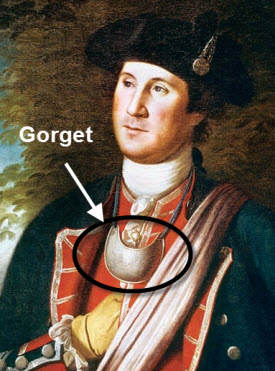Nothing to do with the law
So The Legal Genealogist was poking around in some old records again and came across an estate inventory listing a gorget.
A gorget.
Sure, I have one of those in my … kitchen? My closet? My bathroom?
 Sure I do.
Sure I do.
A gorget is…
A gorget is…
What in the world is a gorget?
So since I had to look it up, maybe you don’t know what it is either.
So I’ll tell you.
I looked it up first in the law dictionaries and, since you can see the image here, with George Washington depicted as a colonel in the Virginia Regiment in the French and Indian War, you probably aren’t surprised that it wasn’t there.
Which meant, of course, I needed to consult with that famous expert and guru of all things knowable…
Dr. Google.
Of the top two choices — both from Wikipedia, “gorget” and “gorget (bird)” — I had a fairly good idea that the item referred to in the estate inventory wasn’t likely to be a reference to something to do with a bird.1
So I looked at the other entry instead, and discovered that:
A gorget, from the French gorge meaning throat, was originally a band of linen wrapped around a woman’s neck and head in the medieval period, or the lower part of a simple chaperon hood. The term subsequently described a steel or leather collar designed to protect the throat, a set of pieces of plate armour, or a single piece of plate armour hanging from the neck and covering the throat and chest. Later, particularly from the 18th century onwards, the gorget became primarily ornamental, serving only as a symbolic accessory on military uniforms, a use which has survived to the modern day in some armies.2
And one of the images illustrating this entry was the one you see part of here.
Fair enough.
Except the inventory was for a lady who’d never married.
I mean, if it had been a widow of a military man, maybe she had kept this as a memento of her late husband. And it is still possible that her father or a brother had been the original owner.
But it seemed to me that if the term started out as something for a woman, it might still mean something a woman a woman might wear.
So I kept looking but kept coming up with things for the guys, and usually armor for the throat.3
Except in one reference book. One I recommend to anybody dealing with records from days gone by when people didn’t alsways use words the way we do today.
In Paul Drake’s What Did They Mean By That?, you’ll find this alternative meaning to the word gorget: “a decorative large pendant, often of some symbolism or religious meaning … e.g., ‘Allison worse a small Indian gorget that Evan had found’…”4
That’s better.
Gorget.
Try that out the next time someone admires the pendant you’re wearing…
SOURCES
Image: Charles Willson Peale (1741-1827), Portrait of George Washington, via Wikimedia Commons
- Google search results, search term “gorget,” Google.com (http://www.google.com : searched 20 Mar 2014). ↩
- Wikipedia (http://www.wikipedia.com), “gorget,” rev. 12 Mar 2014. ↩
- See for example Merriam-Webster Online Dictionary (http://www.m-w.com : accessed 20 Mar 2014), “gorget.” ↩
- Paul Drake, What Did They Mean By That? (Westminster, Md. : Heritage Books, 2000, repub. 2008), 138. ↩



The book, “Colonial American English” by Richard M. Lederer, Jr. says a gorget says, 1. (n)Something for the throat. A piece of armor or a symbolic badge. A 1757 letter to Washington commented, “To see Sash & Gorget with a genteel uniform.”
The second definition refers to a ruff worn by a woman.
Another great resource, thanks. Full cite to the book for folks who want to keep an eye out for this (it’s not currently in print that I can find): Richard M. Lederer, Jr., Colonial American English: A Glossary (Essex, Conn. : Verbatim Book, 1985).
It was a very difficult book to locate and was expensive but for Colonial Research is necessary!
Sitting here debating whether to go for the $50 at AbeBooks marketplace…
You KNOW you want it, Judy!
Of course I do. But there are times when “want,” “need” and “can afford” are all battling it out…